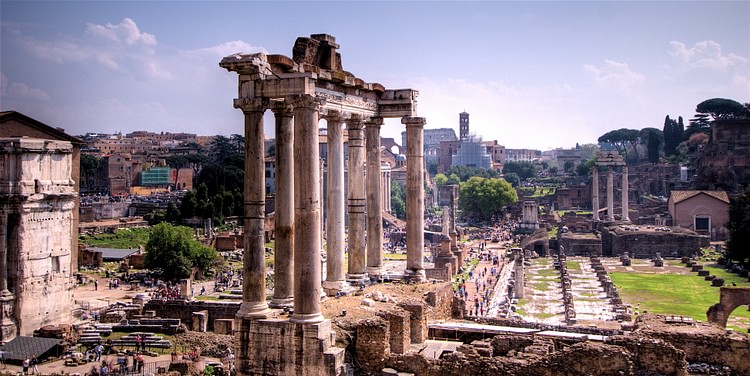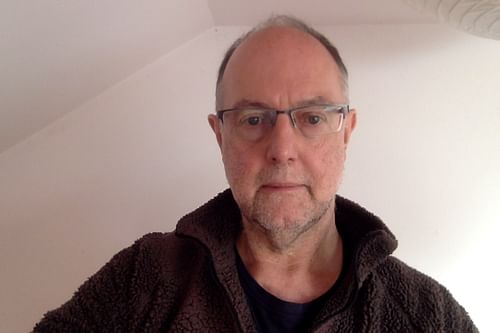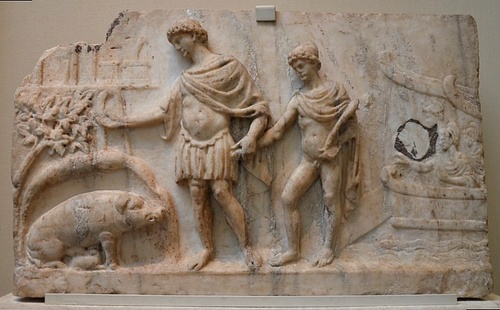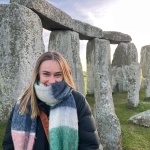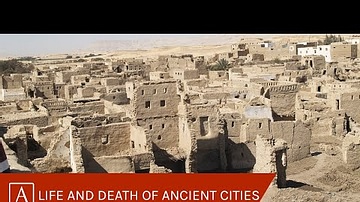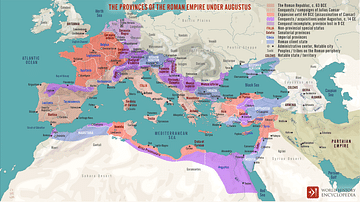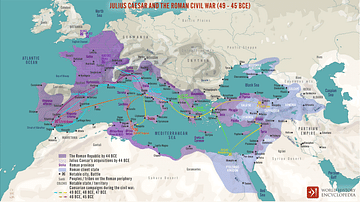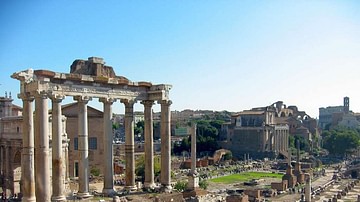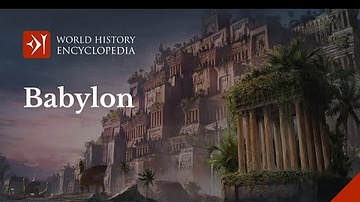Join World History Encyclopedia as they talk to author and professor Greg Woolf all about his book Rome: An Empire's Story, Second Edition, published by Oxford University Press.
Kelly (WHE): Do you want to just tell everyone what the book is about?
Greg Woolf (Author): Well, it is what it says on the cover! It is a total history of Rome. It starts with the 8th century BCE when it is just a scatter of villages, which we only know through archaeology, and it ends up at the 8th century CE when Arab armies have conquered Egypt and Syria, swept along North Africa, and plunged into Spain. For some hundreds of years, the northwest has been ruled by German kings and so on. I start from a tiny city on the river and end up with a tiny city on the Bosporus, and in between, it expands and contracts, just not back to the same point.
Kelly: Fascinating. Do you go through every aspect of the Roman Empire, or is it just the physical growth and development?
Greg: Well, you cannot do everything. I decided when I wrote the first edition that I did not want to just tell the narrative. It has got alternate chapters, there is a chapter of narrative and then there is a chapter taking an issue like religion or the city of Rome or something. And so it alternates all the way through. The thematic ones are organized in a logical order, break down a bit now and again. But it means you can read social history, or you can read the narrative or both.
Kelly: Amazing. Why did you want to write this book on the history of Rome? What made you want to do that?
Greg: When I first wrote it, which is about ten years ago, I come to a phase of my career where I had done a lot of teaching, and I thought it would be nice to pull all this stuff together that I have been learning as I teach because you only really learn something when you have to explain it to somebody else. It was a project to do when I got to a point where I was doing less teaching, I had finished a big admin job. I was on leave for a bit, and it is something you could write almost anywhere if you know the subject. I wrote little bits in Paris, little bits in Brazil, little bits in Germany, and so on. It was a good project to pull it all together, and that is why it is dedicated to my students; it was really through explaining things to them and getting their questions, finding out what they were interested in and what they did not like about what was out there already, that I had a sense of what would work as a one-volume book.
So, that is why I wrote the first one, and then the second edition I wrote ten years later. This was different; this was a lockdown project. Most of it was written in lockdown, so I thought, what kind of writing can I do where I cannot really go and work in my normal way? And I thought, well, what I can write about is the new stuff because most of the new stuff either I owned or is on the web. Now our discipline, like every other, is all virtual online, and all the new journal articles are out there electronically, and many of the books are out there electronically in one form or another.
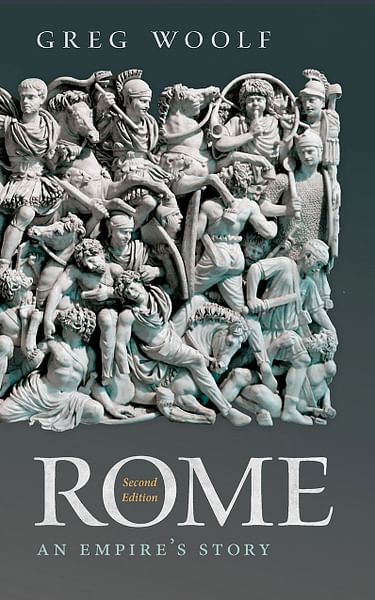
I thought this would be a good chance to sit down and see what has changed in ten years? Of course, lots of bits have not changed, but then other bits have changed enormously. It was really exciting to come back to my own discipline ten years down the line. In the interim, I had been running a research institute in London for six years, so I had a different perspective from teaching in Scotland. One of the great things about the institute in London was we had an amazing library. Scholars came from all over the world. I had been meeting lots of people from Spain, Israel, the US, Germany, and other places who came. So, I got a slightly broader, different perspective. I had also been to visit some of the places that were using my book to teach. I talked to students in Sydney who read the book and wanted to ask questions. I have been to Copenhagen and talked to various other people around the place. Plenty of people told me what they did not like about it, but mostly they thought it was good enough, it was worth having another go at. So, that was my lockdown project to go through the book again and see what was new.
Kelly: Such a global experience but locked down as well. That is awesome. You said that there were some new things that you found ten years after writing the first one. Can you tell us anything that changed between the two editions?
Greg: There have been lots of little bits all over, but perhaps three big new things have happened, one of which I had seen coming, but the other two I had not. The one I had seen coming was I saw that people who worked on ancient history were going to have to do a lot more with natural sciences, with life sciences. In the time between the two books, a lot of work has been done on plagues and epidemics, not really prompted by the pandemic, it started before that. We knew there had been some big plagues sweeping across the Roman Empire. There was a bit about that in the first edition, but we just got a lot smarter. People had DNA-sequenced some of the pathogens. They tracked down things in much more detail, they compared the evidence from different plagues.
But there are also other really cool things like migration. People have been looking at migration mobility a lot more, and there are now some quite interesting ways you can use science to fill out the pictures. For example, bits of our bodies are laid down at different points in our lives. Whenever any bit of you, your teeth, your legs, your hair grows, it takes up trace elements of what is around, what we eat, and particularly the water we drink. If we move about a bit, then they look different. A lot of people have been looking at Roman bones trying to work this out. One of the things we found is that people moved about quite a lot more than we thought in the Roman Empire. So that was one of the new things, life science.
The second new thing is that people have got a lot more interested in archaeology. People have always done archaeology, but they have often done it in a sort of way to illustrate a story that was mostly told by history. You start from what the ancient texts say, and then you illustrate it. There is this bit we do not know much about because ancient writers did not write much about women, so maybe there are some statues of women we can fill in the gap. Archaeology is being used as a kind of filler. Now, in the last ten years, people are much more taken with the idea that there is a story we can tell from material remains that stands on its own. Then, we can use the other stuff as a filler. For example, there is a wonderful book written by a woman named Amy Russell, who is a professor at Brown University on the East Coast. She looked at Rome's own spaces and how the buildings and the structures, the public spaces changed over time. This provided almost like an exoskeleton within which politics happens, but also reflective of politics. So, you can look at how this grows almost as if you were looking at the fossilized remains of some ancient dinosaur. What must the soft tissue have looked like to generate this hard tissue? A strong sort of narrative there. That is the second big thing.
The other thing is that people have worked a lot more around the chronological edges of the Roman story. We know quite a lot more about very, very early Rome and quite a lot more about late Rome. There have been some studies on how Rome interacted with other Italian people in the centuries before there was any local writing. Again, that is the story that also owes a lot to archaeology. So, we have new accounts of that, which are not just the legends of Romulus and Remus and Aeneas but also stories about how different communities of the Italian peninsula come together and form alliances. You can see some of early Rome not so much as one plucky little people conquering all their neighbours but almost as a process by which different groups of local allies pull it together. Of course, Rome still reigns at the centre, but you see how the vested interests of landowners and chiefs and warlords all come together to create an Italy-wide project. Lots more is being done on late Rome, too, on the Christian city after much of the empire is effectively being run by the descendants of people who had been enemies in the past. So, the beginning and the end of my book has expanded a bit, but the middle not so much. Along the way, I was able to pick up on little bits and pieces, too, and generally re-educate myself, which is always fun to do.
Kelly: That is all so exciting. I love the idea of the history of the physical city and its growth and the changes in the buildings.
Greg: It is great. The other thing people have looked at is the way in which objects end up shaping how a people do things. We are used to looking at objects and saying the Romans liked wine, and to transport it, they needed to make particular kinds of pots, which then travelled in particular kinds of boats. We can find the boats and the pots and then tell the story of the wine from that. So we are using archaeology, the material culture as indirect evidence for social processes. But now people are interested in the effect of moving through a world in which everywhere you go, the same kind of pots appear. You travel from Milan to Rome, then you get in a boat to Greece, you travel across to Corinth, take your boat the other way and end up in Ephesus in Turkey, maybe. Everywhere you go, there is material culture reflecting back their values. How does this affect people's collective psychology? People whose ancestors drank beer or lived in very different kinds of houses now find all the same physical setting. What does this Roman sensorium do? How did the objects make each generation more like people who are their contemporaries than like their ancestors? That has been another really interesting strand of work, and it was also fun to follow.
Kelly: That is fascinating because that is not the way you usually think about material objects and artefacts.
Greg: We think about what we do to objects or what we do with objects. Now archaeologists are thinking about what the objects do to us. That is a big difference.
Kelly: Giving objects the agency.
Greg: Exactly.
Kelly: What did you find the most surprising when you're researching the second edition?
Greg: I think the thing I found most surprising was the very early material. At the beginning of my career, I began working on the age of the early emperors. I taught and knew about earlier stuff, I knew a bit back to say 300-400 BCE, but I had more or less decided the earlier stuff was unreachable, that it was just legend and you had to ignore it. They are interesting legends, but they are interesting because they tell you about the people who told those legends. For example, the story that Romans were descended from Trojans is interesting because of how Romans positioned themselves in relation to the Greeks.
I think what I have been really interested in is how much can be worked out about these very early periods, the end of the Bronze Age, the beginning of the Iron Age, where we are beginning to see all sorts of different populations interconnect in the Western Mediterranean. People have been doing excavations in Sardinia and in Africa, looking at early metallurgy, beginning to track down all these strange little languages, which we have tiny bits of in different inscriptions. I think what surprised me was that it was something I had written off, but there was actually more to be done there. It was not me doing it, but it was very good to see what other people have managed to do. Some extraordinary work has been done by Catherine McDonald at Durham and Nicola Terranacha at Michigan. There are also lots of Italian colleagues working in and around the Bay of Naples and the city of Rome itself. Some quite spectacular stuff.
Kelly: That is awesome. I love that it is such an ever-changing and developing study. Archaeology is never going to stop, and we are always going to find new things to inform what we thought we already knew. From your second edition, what is the one thing you think people need to know about your book?
Greg: I think one thing they need to know is that this is quite a live subject, it is quite dynamic. Some things are never going to change, and we are never going to discover that Julius Caesar did not exist or we are never going to reorder the emperors from the 1st century CE. There are some fixed points, but there are many areas where a lot more needs to be done and can be done. So, I hope people who get the second edition and put it lovingly on their bedside table next to the first are going to think, "wow, actually, Roman history is doing things." Not just that I am doing things, I am chronicling, but that over the last ten years we are really moving somewhere. The people who read it may be thinking about what is next. I hope what they will see is that there is a new set of connections to be made between traditional humanities, art subjects, and biological sciences of all kinds. That means people who study the past and the future are going to have to know what an isotope is as well as what an epitaph is. They are going to need to be able to understand a bit about species of different animals and plants, as well as understanding about dynasties of different kinds of aristocrats. They are going to need to know a bit about genetics.
There might have been a time in the past where you could have walked through a door that says "I am only going to study text" or "I am only going to study art" or "I am only going to look at science," but that is gone now. We have all got to be able to know a bit about everything else and be a bit humble about other people's skills because none of us is going to be able to do it all on our own. I hope a lesson people might pick up from this is an all-around education is really worth having. No one bit on its own is going to be sufficient. Probably that works for science as well. Medical humanities are important, but a lot of people are doing things in which they are going to need to think about the human world as well. So, I hope it will point in that direction.
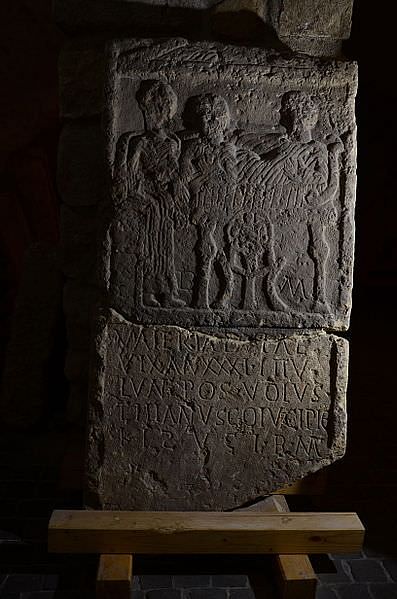
We need to work in teams, we need to work together. The old idea that you go away into a library for three or four years, you write one book on your own, then you come out and you show it to somebody else is gone. We have got to work with each other, and some of the most important work now being done is being done by these climate scientists. The papers have twelve authors because there is a glaciologist and a climatologist, and you need somebody who understands how rocks are formed in caves, and you probably need someone who can read Greek, and you need somebody else who can look at human skeletal material. So, that is one example, but there are other things, too. The big new book of archaeology, Beginnings of Everything is written by a sociologist and economist, David Graeber, and an archaeologist, David Wengrow. They have got together to write an account of everything in the last 40,000 years that neither could have written on their own. I think that is going to be much more what we do in the future. It is much more teamwork.
Kelly: So collaboration is key for the future of learning more about our history.
Greg: I think that is right! The old archaeologist used to go out in the field with one person who was in charge, and they called the shots. Then they had a bunch of little helpers, some of them digging holes, some of them cataloguing, some of them doing geochemical and geophysical stuff as well. Now it has got to be a bit more even, I think.
Kelly: Definitely! It gives you a more well-rounded view of what you are looking at.
Greg: Yes! It was really good fun to write. If there are people in other disciplines who are thinking about writing something very specialised and narrow, yes, do all that because that is what makes us important as scientists and researchers. But every now and again, I found it useful to stick my head up like a meerkat and look around and see what else is going on. I learnt a lot from it, just like I learnt a lot from teaching this stuff. I would really recommend that to anybody else who is tempted to get the big broad brushes out and paint like crazy for a short amount of time, even if there is no lockdown to do it in.
Kelly: Thank you so much for joining me today.
Greg: Well, thanks for having me on, Kelly. Nice to talk.
